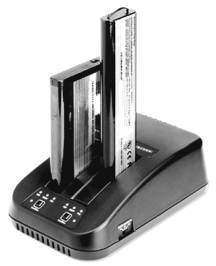<< Previous page INDEX Next page >>
7.5 The Target Capacity Selector
For users that simply need a go/no go answer and do not want to bother about other battery information, chargers are available that feature a target capacity selector. Adjustable to 60, 70 or 80 percent, the target capacity selector acts as a performance check and flags batteries that do not meet set requirements.
If a battery falls below target, the charger triggers the condition light. The user is prompted to press the condition button to cycle the battery. Condition consists of charge/discharge/charge and performs calibration and conditioning functions. If the battery does not recover after the conditioning service, the fail light illuminates, indicating that the battery should be replaced. A green ready light at the completion of the program assures that the battery meets the required performance level.
An SMBus charger with the above described features acts as charger, conditioner and quality control system. Figure 76 illustrates a two-bay Cadex charger featuring the target capacity selector and discharge circuit. This unit is based on Level 3 and services both SMBus and ‘dumb’ batteries.
Some SMBus chargers can be fully automated to apply a conditioning cycle whenever the battery falls below the target setting. An override button cancels the discharge if a fast-charge is needed instead. Such a system maximizes the life of fleet batteries and assures that deadwood is identified and removed.
Figure 7-6:The Cadex SM2+ charger
This Level 3 charger serves as charger, conditioner and quality control system. It reads the battery’s true state-of-health and flags those that fall below the set target capacity. Each bay operates independently and charges NiCd, NiMH and Liion chemistries in approximately three hours. ‘Dumb’ batteries can also be charged.By allowing the user to set the desired battery performance level, the question is raised as to what level to select. The answer is governed by the applications, reliability standards and cost policies.
It should be noted that the batteries are always charged to 100 percent, regardless of the target setting. The target capacity simply refers to the amount of charge the battery has delivered on the last discharge.
A practical target capacity setting for most applications is 80 percent. Decreasing the threshold to 70 percent will lower the performance standard but pass more batteries. A direct cost saving will result. The 60 percent level may suit those users who run a low budget operation, have ready access to replacement batteries and can live with shorter, less predictable runtimes.
Battery SoH readings are only available with Level 3 SMBus chargers servicing valid SMBus batteries. ‘Dumb’ batteries cannot provide SoH readings, even if they share the identical footprint of the ‘smart’ battery and can use the same charger.
